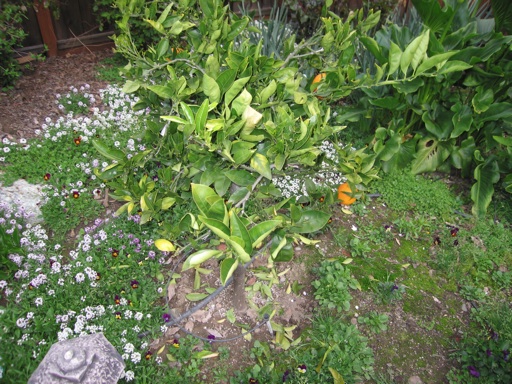
A few weeks ago, I gave our citrus bushes their first application of fertilizer for the season. I have read repeatedly how important it is to fertilize citrus with nitrogen especially in late winter to stimule them to grow and bloom in the spring. I have been using a 16-16-16 all-purpose chemical fertilizer on our citrus. We have two mature orange bushes (below picture), a very small page mandarin bush, and a small navel orange bush (picture above). A week after I applied the fertilizer, the mandarin and the small navel orange bush dropped many of their still green leaves. The picture above show the small navel orange after the leaf drop occurred.
I gave the small orange and mandarin about a cup of fertilizer each, which was probably too much. We had only a few light rain showers in the weeks after I fertilized, and I did not give them supplemental watering. Also, the weather has been cool with many cloudy days in the past few weeks, but we have not had any freezing weather. So I can rule out overwatering and weather conditions as possible causes. Last spring, our small orange lost even more of its leaves within a few weeks after I applied the same fertilizer.
Although leaf drop on citrus can occur for a variety of reasons, I am convinced at this point that the leaf drop has been occurring, because I have been applying too much fertilizer, which burned the roots. I have decided to start using an organic fertilizer on our citrus bushes and to use much less fertilizer, perhaps a third of a cup per application on our small bushes. I have read that organic fertilizer is less likely to burn the roots than chemical fertilizers, because the nutrients in them are much less concentrated. Our mandarin seemed to suffer the most after I gave it fertilizer. That’s strange because it had many yellowing leaves that were a clear sign of nitrogen deficiency. However, it is a very small bush (only about 18″ high), so it was probably more susceptible to root burn.
Our large mature orange bushes did not mind the chemical fertilizer. I gave them about 3-4 cups of fertilizer each. They lost very few leaves after I applied the fertilizer, which seems to confirm what I have been reading that mature trees can handle large doses of fertilizer much better than young trees. In the past few years after giving our 2 large orange bushes a few cups of all-purpose fertilizer in February, they responded by producing an abundance of blossoms and new dark green leaves the following spring.
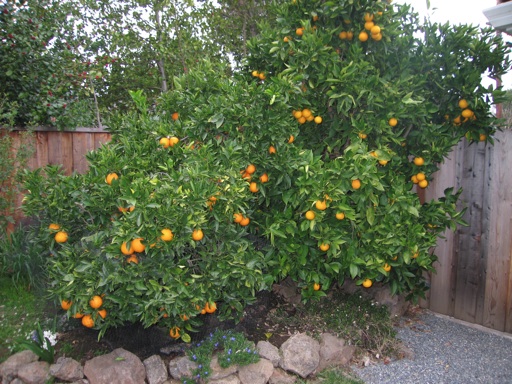
March 07 2010 | Oranges | Comments Off on Leaf Drop on Citrus
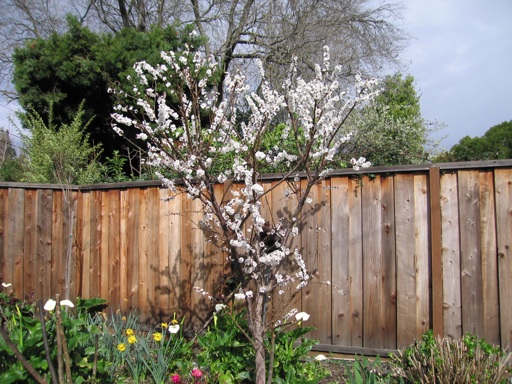
Our 8 year old Blenheim apricot tree just finished its bloom. I took this picture of it last weekend. It started blooming about 2 weeks ago. It was a beautiful but brief bloom. The rain we had here on Tuesday and Wednesday of this week knocked off most of the remaining petals. Our peach, nectarine, and Japanese plum trees are also in bloom now, and there appears to be no shortage of bees pollinating the blossoms.
These trees have always bloomed very early here. Although it varies from year to year, they typically bloom in late February and early March. I think that their tendency to bloom early is part of the reason many peach, nectarine, apricot, and Japanese plums are not recommended for cold climates that are prone to hard freezes late in the season in March and April. An early warm spell could trick them to into bloom and then a subsequent freeze might damage many of the flowers or newly forming fruit.
March 05 2010 | Apricots and Fruit | Comments Off on Apricot in Bloom
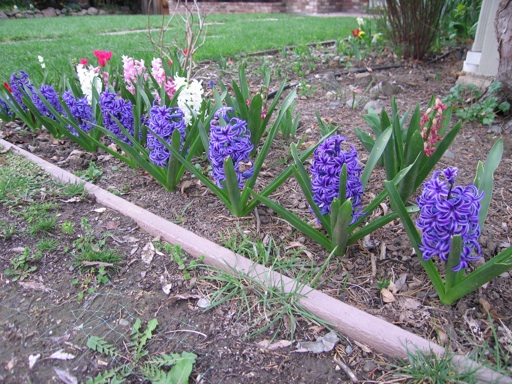
In the fall of 2008, we planted hyacinth bulbs in our yard. Many of those bulbs are blooming for the second time this week. I was surprised to see them bloom a second time with only slightly less vigor than last year, because I have read that we don’t get enough winter chill in our climate to stimulate hyacinths to re-bloom year after year. The hyacinth bulbs I have planted in prior years have tended to come back with less and less vigor each year until they die completely.
Although our hyacinths have been low maintenance flowers otherwise. We get enough rain in the winter months when they are in bloom that we do not need to provide them with supplemental watering. Also, I have not fertilized them.
The blue/purple hyacinth flowers are the most stunning to look at, and this color has re-bloomed the best out of all the hyacinth colors we planted. Although the white hyacinth flowers have by far the best fragrance. We planted more blue/purple and white hyacinth bulbs last fall in different locations (below picture). Those bulbs are a few weeks behind the 2008-09 crop in their bloom cycle.
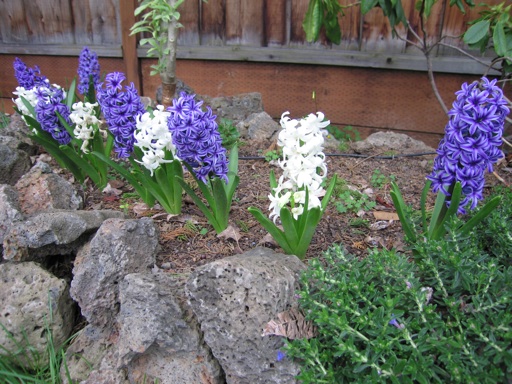
February 28 2010 | Hyacinths | Comments Off on Hyacinth Re-Bloom
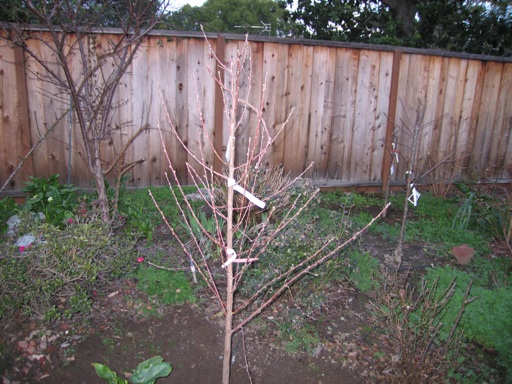

I added a new Arctic Rose nectarine tree to my collection of backyard fruit trees a few weeks ago. The first picture above shows what the tree looked like after I brought it home from the nursery, and the second picture shows how it looked after I pruned it severely, cutting off most of the branches. I have read several resources over the past year about pruning fruit trees. Most of these sources advise home growers to prune fruit trees regularly, especially in the first few years after they are planted when they are still small.
I have always wondered why the branches of many backyard fruit trees bend and break under the weight of the fruit that they bear. Why is it that these trees have not evolved strong enough branches to bear the weight of their fruit? Put another way, why it is that these fruit trees have evolved to bear more fruit than their branches can support the weight of?
The answer is that most of the fruit trees that people grow for food today are not entirely the result of natural selection. Breeders have bred fruit trees such as apples, pears, and peaches to bear large fruits. The wild versions of the fruit trees that we know and love are much more able to support the weight of their fruit, partly because the fruit they bear is much smaller than the cultivated varieties we cherish. For example, today’s large cultivated apples are probably descended from crabapple trees, which produce fruits that are only about 1-2 inches in diameter. Wild peaches trees that grow in their native China produce fruits that are much smaller and more sour that the peaches that are cultivated throughout the world today.
Although fruit tree breeders have been very successful at improving the size and flavor of many modern cultivars of fruit trees, they have not improved the strength of the branches of fruit trees. The only way to do that is to prune often and heavily. Pruning the branches of a tree stimulates the tree to thicken and strengthen the shortened branches that remain, making them much better able to support the weight of a heavy load of large fruits.
I am now pruning my fruit trees 1-3 times a year so that they can support the weight of their fruit without needing supports or causing branch breakage. Depending on how fast an individual tree is growing, I sometimes prune the same tree as often as 3 times per year, in the winter, in the spring, and in the summertime. Many of my fruit trees grow rapidly in the spring after a winter prune. Spring and summer pruning does a good job of reducing the vigorous growth rate of trees. Frequent pruning has kept our fruit trees small so that it is easier to spray them (if needed), net them, harvest the fruit, and perform subsequent pruning.
I have read repeatedly that is especially important to prune peach and nectarine trees heavily, because they grow vigorously and produce many more fruits than they can support. I think that at least 2/3 of the branches of a peach/nectarine tree should be removed each year to control its size and fruit production. If pruning doesn’t do enough to reduce the number of peach or nectarine fruits a tree produces, I will thin the fruits to about 4-6 inches apart in May-June. Thinning the fruit greatly reduces the likelihood of branches breaking. Also, in the years that I thinned my peaches, my O’Henry peach tree has produced peaches that are much larger in size than in the years I have not thinned them.
February 20 2010 | Fruit and Peaches/Nectarines | Comments Off on Severe Pruning of Fruit Trees
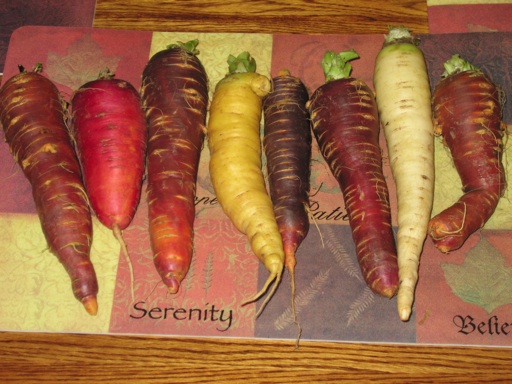
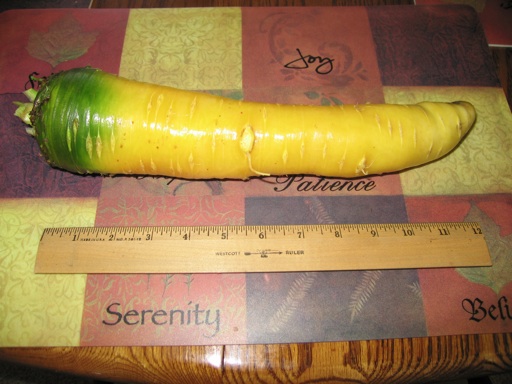
Last spring, I planted rainbow carrot seeds in our vegetable garden. I planted a second crop of rainbow carrot seeds in our garden last September. This week, I harvested the remaining carrots from the spring crop. The first picture above shows some of the red, purple, white, and yellow carrots I harvested. The only color of carrots I didn’t harvest was orange!
These carrots had been in the ground a long time (nearly 10 months). Many of them had grown to be very large. And I don’t remember ever fertilizing them. They don’t seem to need it. Carrots are one of the lowest maintenance vegetables that I have grown. The carrot in the bottom picture has a green top, because that part of the carrot was protruding above the ground.
I have heard that carrots can be left in the ground over the winter, and that the cold winter weather stimulates them to get sweeter. This week we received nearly 6 inches of rain. So I decided to harvest the rest of the spring carrots, because I was concerned that they might start rotting in the ground. In fact, some of them already had a few brown spots.
Some of our carrots were forked. Carrots tend to get forked when their roots run into rocks or hard dirt clods. Also, some of our carrots had split open, possibly because of too much watering during the growing season. But one of the nice things about vegetables is that even the less than perfect looking ones are still edible. Once they are sliced and cooked, who can tell the difference anyway?
January 24 2010 | Carrots | Comments Off on Winter Rainbow Carrots
« Prev - Next »








